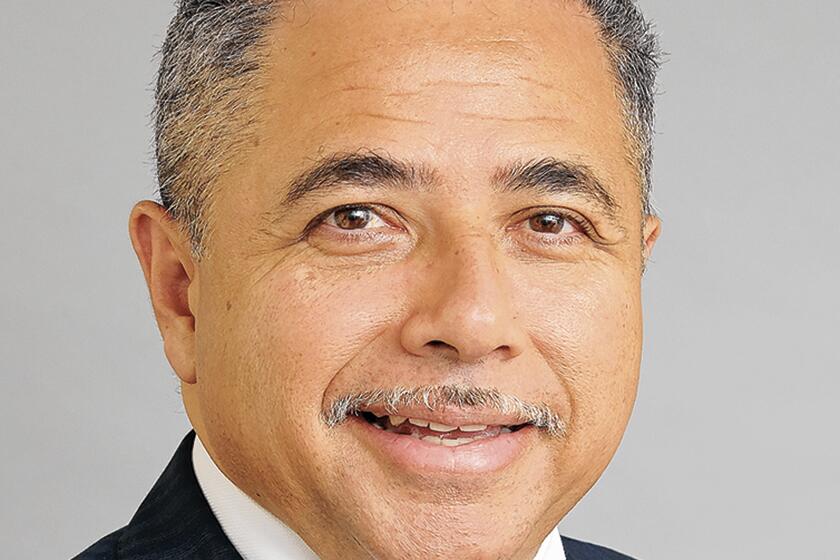2023 Commercial Real Estate Insights from John Murillo of Enterprise Bank & Trust
- Share via
The Commercial Real Estate Strategies Q&A is produced by the L.A. Times B2B Publishing team in conjunction with Enterprise Bank & Trust.
Over the last few years, in the wake of a series of unanticipated challenges ranging from a global pandemic, supply chain issues, new workplace trends and increasing interest rates, commercial real estate companies have had to get creative. The lingering elements of change and management of new protocols have continued to force the industry to assess and, in many cases, make permanent changes to their operations and how they approach relationships with partners, customers, and employees.
As we move into the second half of 2023 and as things return to a new form of normal, questions still linger. What changes and trends are here to stay for the long term? What new roles is technology playing? What will the CRE industry look like a year from now?
We turned to a uniquely knowledgeable expert John Murillo from Enterprise Bank & Trust for his thoughts and insights about what’s next for Southern California’s resilient commercial real estate sector.
Q: What are the key opportunities and risks for developers in 2023?
At the mid-year point of 2023, we see areas of opportunity and risk in commercial real estate. We continue to notice opportunities in the multi-family space and are seeing record capital investment levels nationwide. Our strong local job market and increases in home and rent prices lead to a strong demand for rental housing. Demand for industrial is high. Lack of supply leads to higher rental rates. On the other side, there are risks that developers continue to face. Developers, since the COVID-19 pandemic, are still battling with higher costs due to a shortage in the labor force, dealing with an increase in the costs of their existing labor force, facing higher costs in materials, and – overall, because of these factors – are seeing longer timelines for completion of their key projects.
Q: What do you consider to be the most meaningful positive trend in commercial real estate currently?
The most positive trend in the commercial real estate industry currently is that vacancy is not outpacing the long-run average of around 45%. In addition to that, Los Angeles’ strong job market and large population continue to drive strong demand for rental housing.
Q: Any negative trends you hope will go away?
Because of the current environment, we see higher interest rates and uncertainty in the market. These factors naturally lead to lower transaction volumes, indicated by debt and sales being down over the recent months. In addition to that, we see capital is avoiding the office market today post-COVID-19. We suspect that the traditional office space market will struggle with vacancies and that is impacting capital’s willingness to invest in developments in the space in the coming years.
Q: What is a good strategy for business owners in terms of commercial real estate and the remote work trend?
It is human nature to interact with others. Business owners need to create a space that facilitates more interaction and collaboration. The new buzzword in the office space is hybrid, which is giving employees the flexibility for work-life balance and traveling into the office only a few days a week. One thing to call out to business owners is that you have control over your workplace culture and environment. The better environment you create for your employees, the better attendance you will see on your days in the office, and the overall engagement from employees. Business owners should also look for ways to reposition or for adaptive uses for their properties. With a growing focus on Environmental, Social and Governance (ESG) mandates, you can start thinking about your resources and strategy for the future now.
Q: What changes are you seeing in how buyers and sellers are reacting to current market dynamics?
Buyers and sellers are somewhat taking a step back. There are prudent buyers and sellers who understand that the tightening cycle may end in the next 12 to 18 months. They are ignoring the noise as much as possible because they understand that the current economic situation in the United States is not going to be this way forever and instead are taking a more macro view on how current dynamics are impacting their business and what impact it will have in the future.
Q: What parts of Southern California do you see as “hot spots” for commercial development in the coming months and years?
A few pockets of Los Angeles are seeing positive indicators for sustained commercial development in the coming months and years. The Hollywood and West Hollywood areas have received support to push the proposed large development projects forward. In addition to Hollywood and West Hollywood, Northeast Los Angeles and Lincoln Heights areas are starting to see support for repurposing city and county-owned properties. Southern California will continue to see increased demand for residential real estate purchases and development. These factors will help contribute to new development projects in Southern California for the coming months and years.
Q: What are your predictions for what the office of the future will be like?
Expanding on my previous comments about co-working spaces, employees and business owners are continuing to push toward co-working spaces or more flexible office spaces to work. We have seen these become popular over the years and will probably continue to see this trend grow moving forward. Employers are looking for office space that can be scaled up and down to avoid the overhead cost associated with owning commercial real estate. Co-working space also gives employers the ability to offer employees more amenities and newly updated workspaces in a co-working setting. The flexible, shared office space model is not going anywhere anytime soon. We are continuing to see businesses move to more hybrid work environments.
“Southern California will continue to see increased demand for residential real estate purchases and development.”
— John Murillo
Q: What changes do you anticipate impacting retail?
I expect we will continue to see a shift away from the traditional retail space. There is going to continue to be an emphasis on e-commerce. Over the years, we have seen buyers’ purchasing habits shift away from additional brick-and-mortar to online shopping, and this trend is not slowing down. Buyers continue to look for efficiencies and convenience when shopping and making decisions, and online shopping puts that into their hands immediately. The shift has already started as across the country warehouse property development or transactions are on the rise due to the focus and success of e-commerce for most businesses.
Q: What do tenants need to be thinking about as they seek new spaces in 2023?
Tenants are in luck. There continues to be a rise in sublease availability; subleases give tenants flexibility, which is not usually the case as they are normally discounted compared to a direct lease. In addition, we are seeing large office space requirements on hold, which favors tenants now.
Q: What advice would you offer commercial real estate investors today?
Investors need to be aware and ready to navigate the changing sources of lower occupancy requirements, demographic trends and market demand. I would also advise investors to have strong relationships with their key business partners. These strong relationships will bear fruit when you least expect it, and building or fostering those relationships now will set you up for future success.
Q: What effect do interest rates have on today’s market?
We see owners delaying refinancing as long as possible. In some cases, reached maturities are forcing the need to refinance, which is where we see owners looking to short-terms in order to position themselves positively for when interest rates begin to decline. Naturally, rising interest rates decrease buying power and can lead to an overall decrease in new developments and transactions.
Q: What new trends do you foresee coming to our local industry by the end of this year?
Loan maturities are expected to increase by over 50% next year. Because of this, significant transaction volume will be generated for the Los Angeles metropolitan area in 2024. Also, like stated before, we may see some transactions put on hold due to the current economic environment.
John Murillo continues to build on an already remarkably distinguished career in financial services, currently serving as SVP, market president for Enterprise Bank & Trust in Los Angeles






